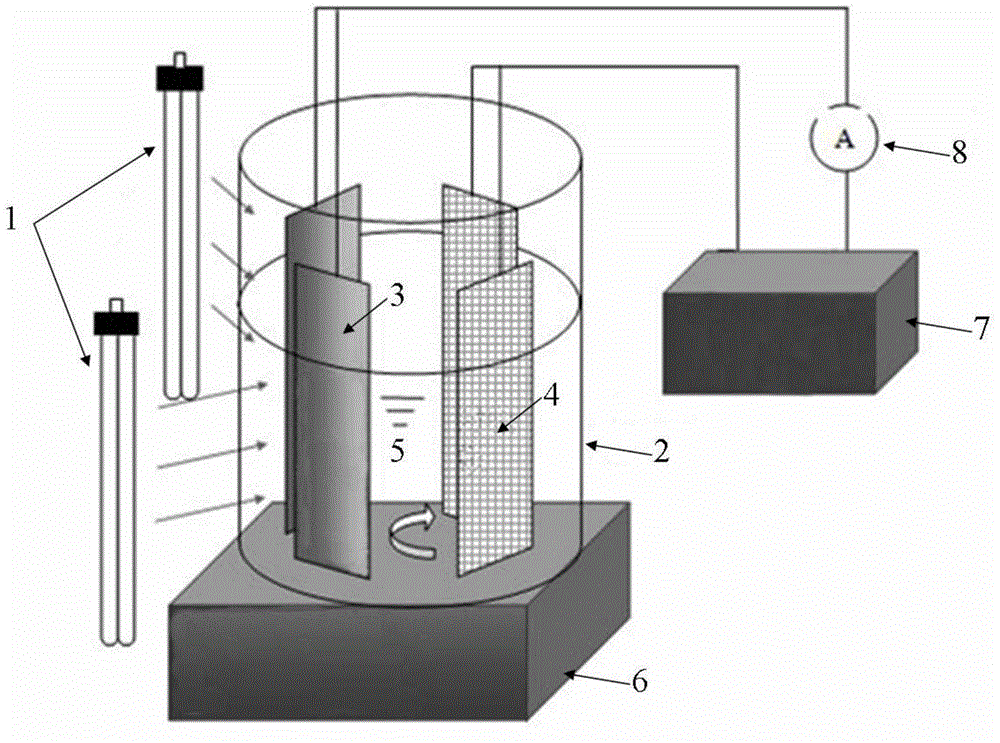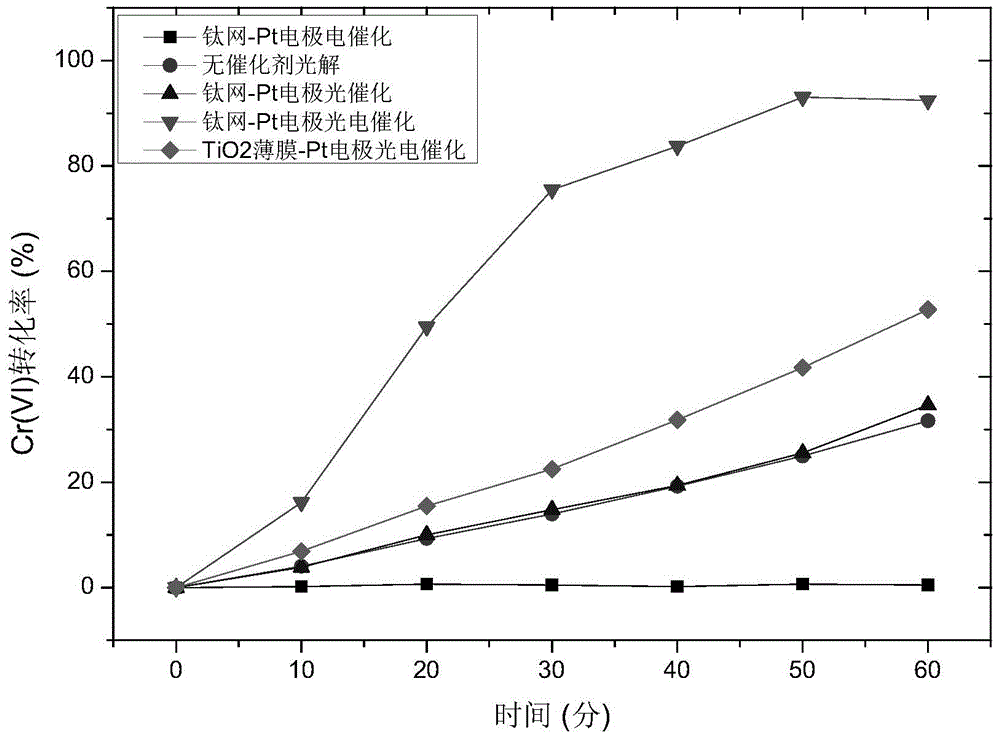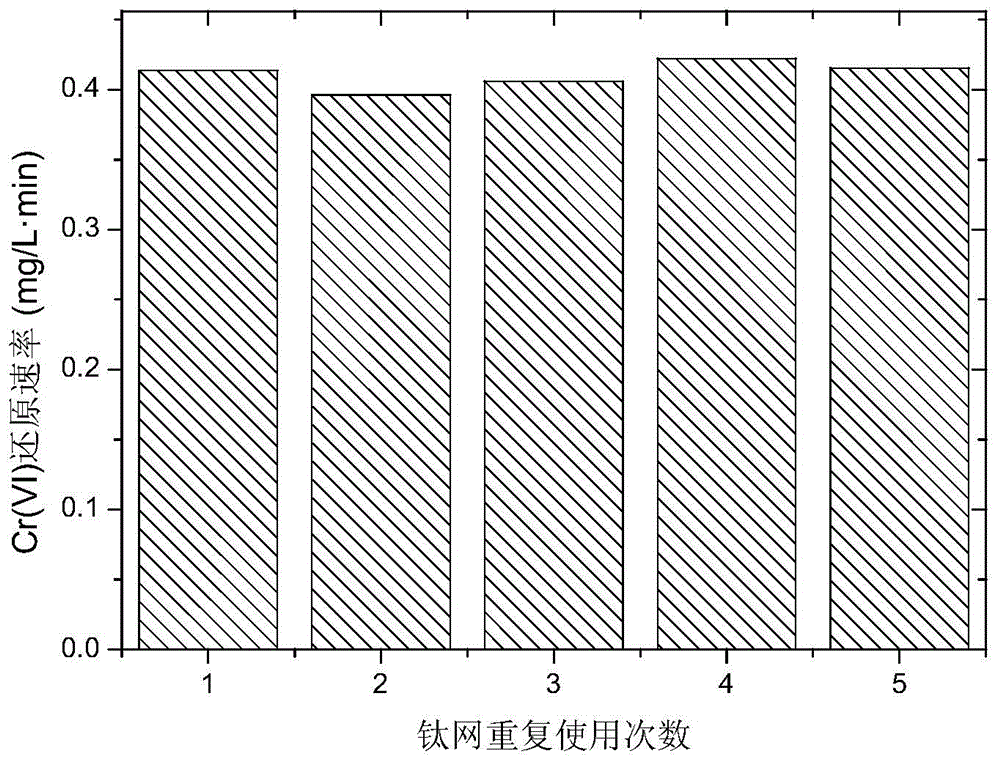Method and device for removing heavy metal ions in wastewater by virtue of photoelectrocatalysis
A heavy metal ion, photoelectric catalysis technology, applied in chemical instruments and methods, light water/sewage treatment, water/sewage treatment, etc., can solve the problems of high energy consumption, high cost, low voltage efficiency, etc., achieve low energy consumption, Simple method and high voltage efficiency
- Summary
- Abstract
- Description
- Claims
- Application Information
AI Technical Summary
Problems solved by technology
Method used
Image
Examples
Embodiment 1
[0033] In this embodiment, a titanium mesh is used as a photoanode, and a Pt electrode is used as a counter electrode to remove Cr(VI) ions in wastewater.
[0034] The preparation method of the photoanode: cut the titanium mesh purchased in the market into a certain size rectangle, and then ultrasonically clean it in acetone, ethanol, and deionized water, and then wash it in HF:HNO 3 :H 2 Polish in O=1:3:16 mixed solution for 30s, rinse with deionized water, and dry.
[0035] The preparation method of the counter electrode: After polishing the Pt electrode purchased in the market with sandpaper, immerse it in dilute nitric acid for a period of time, rinse it with deionized water after taking it out, and dry it in the air.
[0036] In this example, a 76mm×26mm titanium mesh (thickness 0.2mm, purity 99.9%, wire diameter 0.12mm, mesh number 60 mesh) was used as the photoanode, the Pt electrode was used as the counter electrode, and the cathode-to-anode area ratio was 1:50. The ...
Embodiment 2
[0039] Using the method and device of the present invention, the initial concentration of Cr(VI) in the reaction system is 0.34mmol / L, reaction conditions: pH3.4, citric acid 0.5mmol / L, Na 2 SO 4 0.5mol / L, voltage 1.5V. Reproducible experiments for photocatalytic reduction of Cr(VI) using Ti mesh photoanode and Pt electrode photocathode. image 3 It means that the same clean titanium mesh was used to repeat 5 experiments, and the relative standard deviation of the 5 experiments was 2.4%, and the repeatability was very good, indicating that the titanium mesh can be used repeatedly for a long time.
Embodiment 3
[0041] Using the method and device of the present invention, the initial concentration of Cr(VI) in the reaction system is 0.34mmol / L, reaction conditions: pH3.4, citric acid 0.5mmol / L, Na 2 SO 4 0.5mol / L, voltage 1.5V. Using the Ti mesh photoanode and Ti mesh photocathode to carry out the photocatalytic reduction experiment of Cr(VI), 76% of Cr(VI) with an initial concentration of 0.34mmol / L can be degraded within 60 minutes.
PUM
| Property | Measurement | Unit |
|---|---|---|
| thickness | aaaaa | aaaaa |
Abstract
Description
Claims
Application Information
 Login to View More
Login to View More - R&D
- Intellectual Property
- Life Sciences
- Materials
- Tech Scout
- Unparalleled Data Quality
- Higher Quality Content
- 60% Fewer Hallucinations
Browse by: Latest US Patents, China's latest patents, Technical Efficacy Thesaurus, Application Domain, Technology Topic, Popular Technical Reports.
© 2025 PatSnap. All rights reserved.Legal|Privacy policy|Modern Slavery Act Transparency Statement|Sitemap|About US| Contact US: help@patsnap.com



